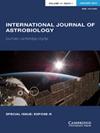Stromatolite photomorphogenesis: lighting up their shape
IF 1
4区 物理与天体物理
Q3 ASTRONOMY & ASTROPHYSICS
引用次数: 0
Abstract
Most stromatolites are built by photosynthetic organisms, for which sunlight is a driving factor. We examine stromatolite morphogenesis with modelling that incorporates the growth rate of cyanobacteria (the dominant stromatolite-builder today, and presumably through much of the past), as a function of the amount of irradiance received. This function is known to be non-monotonic, with a maximum beyond which growth rate decreases. We define optimal irradiance as that which generates maximal growth, and we find fundamentally different morphologies are predicted under suboptimal and superoptimal direct irradiance. When the direct irradiance is suboptimal, narrow widely spaced columns are predicted, with sharp apices resembling conical stromatolites. When it is superoptimal, broad, closely spaced, flattened domical forms appear. Such disparate morphologies could also occur as a result of other vector-flux-dependent growth factors (e.g. currents). A differential equation is developed that describes the rate of change of the radius of curvature R at the apex of a growing stromatolite column, allowing simple simulations of the time evolution of R for model stromatolites. The term photomorphism is proposed to describe the disparate morphologies that may arise due to the effects described here (and photomorphogenesis as the process). Model results appear to explain, at least qualitatively, the morphologies of a number of stromatolites. If stromatolites are encountered on Mars, our model suggests that they are quite likely to be conical in form, owing to likely suboptimal irradiance since Mars has always received less irradiance than Earth.叠层石的光形态发生:照亮它们的形状
大多数叠层石是由光合生物建造的,阳光是其驱动因素。我们通过建模来研究叠层石的形态发生,该建模结合了蓝细菌(当今占主导地位的叠层石建设者,可能在过去的大部分时间里都是如此)的生长速度,作为接收到的辐照度的函数。已知该函数是非单调的,具有最大值,超过该最大值增长率下降。我们将最佳辐照度定义为产生最大生长的辐照度,我们发现在次优和超优直接辐照度下预测的形态有根本不同。当直接辐照度次优时,预测窄而宽的柱状物,其尖锐的顶点类似于圆锥形叠层石。当它是超优的,宽,紧密间隔,扁平的圆顶形式出现。这种不同的形态也可能是其他矢量通量相关生长因子(例如电流)的结果。建立了一个微分方程,描述了生长中的叠层石柱顶点曲率半径R的变化率,从而可以简单地模拟模型叠层石的R的时间演变。光形态一词被提出来描述由于本文所述的效应(以及光形态发生过程)而可能出现的不同形态。模型结果似乎至少在定性上解释了一些叠层石的形态。如果在火星上遇到叠层石,我们的模型表明,它们很可能是圆锥形的,因为火星的辐照度总是比地球低,所以可能是次优的。
本文章由计算机程序翻译,如有差异,请以英文原文为准。
求助全文
约1分钟内获得全文
求助全文
来源期刊

International Journal of Astrobiology
地学天文-地球科学综合
CiteScore
3.70
自引率
11.80%
发文量
45
审稿时长
>12 weeks
期刊介绍:
International Journal of Astrobiology is the peer-reviewed forum for practitioners in this exciting interdisciplinary field. Coverage includes cosmic prebiotic chemistry, planetary evolution, the search for planetary systems and habitable zones, extremophile biology and experimental simulation of extraterrestrial environments, Mars as an abode of life, life detection in our solar system and beyond, the search for extraterrestrial intelligence, the history of the science of astrobiology, as well as societal and educational aspects of astrobiology. Occasionally an issue of the journal is devoted to the keynote plenary research papers from an international meeting. A notable feature of the journal is the global distribution of its authors.
 求助内容:
求助内容: 应助结果提醒方式:
应助结果提醒方式:


